May 26, 2009
Biology textbook authors in the first decades of the twentieth century, exploiting cultural anxieties fanned by Madison Grant, Henry Fairfield Osborn, Paul Popenoe and other eugenic theorists, helped undercut democracy and shore up the status quo by “confirming” suspicions that the “strongest” weren’t breeding, the “weakest” weren’t dying and that workers who did not know their genetically-determined place were a threat to the social order.
Into the 1940s, these authors provided an assist to the powers that be by blithely promoting eugenic marriage, forced sterilization of the “feebleminded” and, um, carefully considered career choice as necessary to keep industrial culture “evolving” along its proper progressive path. As Alfred Kinsey (yes, that Alfred Kinsey) counseled in his textbook, “there are really very few of us who have the necessary heredities to make good Presidents of the United States.” (Kinsey 1926, 174; Kinsey 1933 and 1938, 387-88.)
It was all quite reactionary, and generally uncontroversial. That is until World War II, when in a flash it became uncool to casually disrespect democracy, promote authoritarian control or “prove” ones arguments for managed progress based on hierarchical notions of race and class.
Few textbooks made it through unscathed.
The only textbook to survive without significant injury was the newest, Ella Thea Smith’s Exploring Biology, first published by Harcourt, Brace and Company in 1938. Smith, whose text was more student empowering and less prescriptive to begin with, was able to dial back her eugenics and introduce and promote a contemporary view of race without significantly altering her text’s general structure or point of view. Smith’s book would go on to claim about a quarter of the textbook market.
Older textbooks didn’t fare as well.
Kinsey abandoned his New Introduction to Biology, first published as An Introduction to Biology in 1926, after its 1938 edition. George W. Hunter, famous for his 1914 “Scopes textbook,” Civic Biology, saw sales of his later American Book Company texts drop off through the 1930s. Smallwood’s New Biology (1924) from Allyn and Bacon, Baker and Mills Dynamic Biology (1933) published by Rand McNally, and the variously titled textbooks by Curtis, Caldwell and Sherman (Biology for Today, etc., 1934) published by Ginn all suffered similar pre-war/post-war fates.
Though Moon and Mann’s Biology (originally Biology for Beginners, 1921) did survive, indeed thrive, it survived in authors’ names only. With both original writers dead, Henry Holt and Company called on James H. Otto to completely revise the text in 1947. Under a new title, Modern Biology, Otto totally abandoned the Hunter-inspired structure Moon had copied in 1921, and adopted the more contemporary chapter structure pioneered by Smith.
After the war the best books got better. Vance and Miller’s strong Biology For You published in 1946 set a new “scientific” high bar. Smith, working in collaboration with George Gaylord Simpson through her publisher, introduced students to the modern synthesis in 1949, well ahead of most college texts. However, not all the post-war books were so good. With race and class off the table, the meaning of evolution, so clear to Hunter in 1914, had lost its propulsive culture saving power. Save for Smith, Vance and Miller, and Moon, Mann and Otto (if we’re feeling generous), post-war textbooks decayed into a generalized mass of plants, bugs, health and civics.
However, in the background, a new “middle generation” of eugenicists (labeled “reform eugenicists” by Daniel Kevles), key among them Julian Huxley, Frederick Osborn and Hermann J. Muller, kept the dream of an activist biology alive. It would take 15 years, but these reformers – with their ground prepared by a new generation of anxiety producing social theorists including William Vogt, Harrison Brown, and Dixie Cup magnate Hugh Moore – managed by the early 1960s to establish updated rationalizations upon which to base a second wave of prescriptive biology texts. Under the chairmanship of Bentley Glass, an admirer of Frederick Osborn and former student of Muller, the federally-funded Biological Sciences Curriculum Study funneled millions of Cold War dollars into the development of three new textbooks, the BSCS Yellow, Blue and Green Versions, all first published in 1963. These texts not only “boldly reintroduced” the topic of evolution the high school curriculum, they reintroduced dramatic (though contradictory) claims concerning its meaning. In the process these texts helped spark a tedious and terribly intellectually diminishing culture war that still wages today.
